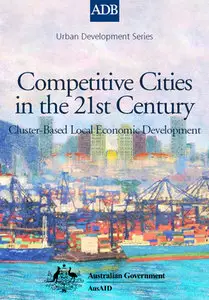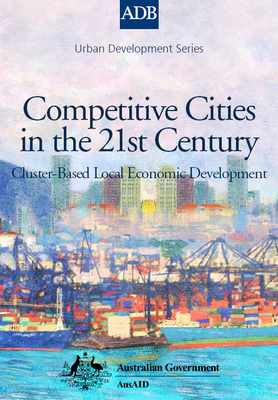Competitive Cities in the 21st Century: Cluster-Based Local Economic Development
Urban Development Series
ADB Publishing | 2011 | ISBN: 9789290924302 9789290924319 | 356 pages | PDF | 5 MB
Urban Development Series
ADB Publishing | 2011 | ISBN: 9789290924302 9789290924319 | 356 pages | PDF | 5 MB
The City Cluster Economic Development approach provides a strategic framework and a set of analytical tools, which governments, businesses, and communities can use to support the inclusive and sustainable development of competitive urban economies in Asia.
Said approach was developed and tested by the ADB to improve the basis for integrated planning and development of urban regions in Asia and the Pacific. It also helps urban managers and other city stakeholders identify action plans and determine priority investment areas.
Contents
List of Tables
List of Figures
Abbreviations
Foreword
Preface
Acknowledgments
CHAPTER 1 CITy CoMPETITIvENESS AND CLUSTER-BASED
ECoNoMIC DEvELoPMENT
1.1 The Competitiveness of Asian Cities
1.2 Shaping Local Economies with Competitive Advantage
1.3 Agglomeration and Transformation of Asian Cities
1.4 Cluster-Based City Economic Development
1.5 Changing the Development Paradigm for Asian Cities
CHAPTER 2 FACToRS ShAPING ThE SPATIAL AGGLoMERATIoN oF ASIAN CITIES
2.1 The Changing Economic Geography of Asian Cities
2.2 Dynamics of Urban Economies
2.3 Push–Pull Factors Influencing the Agglomerated Economies of Asian Cities
2.4 Spatial Planning Approaches to Fostering the Economic Development of Urban Regions: Issues
2.5 old Models of Urban Growth Must Change
CHAPTER 3 EMERGING FACToRS ACCELERATING URBAN ECoNoMIC GRowTh
3.1 Demand-Driven Economic Development: Strategies and Approaches
3.2 Factors behind Demand-Driven Economic Development
3.3 Creating New Pathways for Sustainable Urban Economic Development in Asia
CHAPTER 4 ThE CLUSTER: ThEoRy, ANALySIS, AND ExPERIENCE IN AGGLoMERATED ASIAN CITIES
4.1 Porter’s Theory of the Competitive Advantage of Clusters
4.2 The Concept of Clusters
4.3 Review of the Literature on Clusters
4.4 Tools for Cluster Analysis
4.5 Competitive Cluster Development Initiatives
4.6 Applying the Lessons from Industry Development toCluster-Based Economic Development
CHAPTER 5 BUILDING CoMPETITIvE LoCAL ECoNoMIES: APPRoACh AND ANALyTICAL STEPS
5.1 The Three Principles of Competitiveness in New Urban Economies
5.2 Step 1: Review the National and Local Economic Policy Environment
5.3 Step 2: Analyze the Six Drivers of City Competitiveness
5.4 Step 3: Explore National and Local Multi-Sector Industry to Understand the Industry Structure
5.5 Step 4: Investigate Clusters by Industry Sector at the Selected City Level
5.6 Step 5: Evaluate Gaps in Competitiveness of the Selected Industry Clusters
5.7 Step 6: Prepare a Strategic Plan for Industry Cluster Development in a City or City Region
5.8 Step 7: operationalize the Cluster Development Plans in a City or City Region
5.9 Replicate the Cluster-Based City Economic Development Approach
CHAPTER 6 CLUSTER-BASED CITy ECoNoMIC DEvELoPMENT IN BANGLADESh
6.1 Urban Growth and Economic Development
6.2 Cities’ Competitiveness and Ranking
6.3 Multi-Sector Industry Analysis
6.4 Competitiveness of the Dhaka Capital Region
6.5 Analysis of Three Industry Clusters in the Dhaka Capital Region
6.6 Analysis of the Textile and Ready-Made Garments Industry Cluster in the Dhaka Capital Region
6.7 Analysis of the Leather Industry Cluster in the Dhaka Capital Region
6.8 Analysis of the Food and Beverage Industry Cluster in the Dhaka Capital Region
6.9 Cluster-Based City Economic Development in the Dhaka Capital Region: A Summary
CHAPTER 7 CLUSTER-BASED CITy ECoNoMIC DEvELoPMENT IN INDIA
7.1 Urban Growth and Economic Development
7.2 Competitiveness of Cities
7.3 Multi-Sector Industry Analysis of the Central National Capital Region
7.4 Emerging Patterns of Industry Clusters in the Central National Capital Region
7.5 Diamond Model Analysis of Three Industry Clusters in the Central National Capital Region
7.6 Conclusions
CHAPTER 8 CLUSTER-BASED CITy ECoNoMIC DEvELoPMENT IN SRI LANKA
8.1 Urban Growth and Economic Development
8.2 Competitiveness of Cities
8.3 National and Local Multi-sector Industry Analysis of the Colombo Metropolitan Region
8.4 Geographic Mapping of Three Industry Clusters in the Colombo Metropolitan Region
8.5 Analysis of Three Industry Clusters in the Colombo Metropolitan Region
8.6 The Textiles and Apparel Industry Cluster
8.7 Information and Communication Technology and ICT-Enabled Industry Cluster
8.8 Rubber Industry Cluster
8.9 Conclusion
CHAPTER 9 INSIGhTS GAINED FRoM ThE ThREE CoUNTRy CASE STUDIES
9.1 City Competitiveness Index Scores
9.2 Relationship between City Size and Competitiveness
9.3 Analysis of the Six Key Drivers of City Competitiveness
9.4 Multi-Criteria Analysis of City Competitiveness and Multi-Sector Industry Analysis of Capital City Regions
9.5 Structural Changes in the Economies of the Capital Cities
9.6 Mapping out Industry Clusters by Standard Industrial Classification
9.7 Deficiency Gap Analysis
9.8 Action Planning for Cluster-Based City Economic Development
9.9 Pre-Feasibility Studies for CCED
9.10 Fostering Industry Clusters at Different Stages of Development
9.11 other Insights Gained from the CCED Approach
CHAPTER 10 A NEw PARADIGM oF LoCAL ECoNoMIC DEvELoPMENT FoR GRowING ASIAN CITIES
10.1 Salient Features of the CCED Approach
10.2 CCED Applications in official Development Assistance
10.3 Aiming for Maximum Impact with Limited Resources
10.4 Key observations: A Summary
10.5 Next Steps
REFERENCES
with TOC BookMarkLinks



